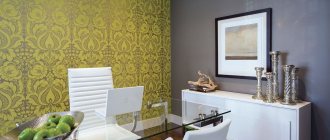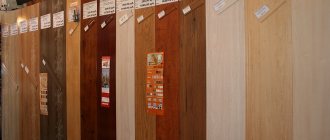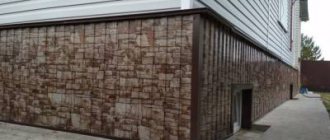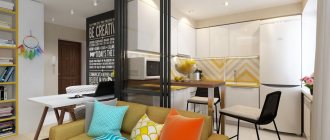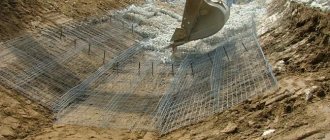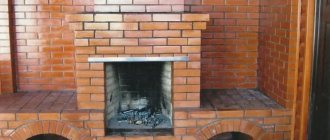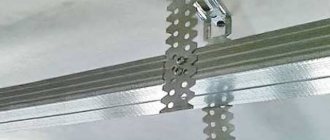Often, renovations in the hallway raise a lot of questions and controversial situations. It would seem that this is not a kitchen, where everything is subject to the demands of a demanding housewife, and not a living room, from which comfort is expected for guests and owners. But the hallway creates the first impression of your home, so we’ll talk about finishing work in this room.
In order for your home to always delight you with its original appearance, you need to pay great attention to the design of the hallway.
Decorating the hallway with decorative stone and wallpaper
Recently, it has become fashionable to decorate hallways with decorative stone and wallpaper.
This design is already a trend. The stone goes well with wallpaper. This decoration will help to unusually emphasize the geometry of the space and give the corridor a sophisticated and rich look. It is worth saying that performing such cladding is not difficult. There is a large selection of wallpaper and decorative stone on the market, and everyone can find a suitable option. An original solution would be to place on the walls rolled materials with a stone pattern, complemented by plaster imitations. Currently, many designers propose using wall coverings in combination with laying decorative stone to decorate hallways. By combining such finishing materials, you can achieve a stunning effect in the interior. You can decorate in this way not only the walls of the hallway, but also the hallway. This finish looks chic and suits any style.
Recommended articles on this topic:
- Arrangement of a small apartment
- Stages of renovation in an apartment
- Turnkey cosmetic repairs
In addition, caring for walls decorated in this way is easy, and the wear resistance of the materials is high. Before you start finishing, you need to correctly calculate the configuration of the walls, take into account the level of lighting and the dimensions of the hallway. If the room is small, then this design will visually make it even smaller. If you frame the openings with mirrors, you can achieve a visual expansion of the space.
By combining materials when finishing the hallway, you get the following advantages:
- Decorative stone harmoniously combines not only with wallpaper, but also with other types of finishing materials (tiles, wood, plaster);
- The range of decorative stone is huge (various colors, textures, shapes);
- The combined finish looks stylish and respectable;
- The performance characteristics of decorative stone are good;
- Finishing work does not require special skills; Anyone can hang wallpaper and cover it with stone.
If you want to combine finishing materials when decorating the hallway, then keep in mind that the color of the wallpaper should be in harmony with the color of the decorative stone. For example, if you are planning to make a room in light colors, this will help visually expand it. Dark finishes will look richer and brighter.
Let's figure out what types of wallpaper you can combine decorative stone with
Decorative stone is a unique material, so it can be combined with any type of wallpaper. However, when choosing canvases, it is necessary to take into account the functions that the hallway will perform. In addition, it is necessary to decide how actively it will be used and what operational tests it will undergo.
In order for this finish to last a long time, wallpaper should be purchased of high quality. A good option is to decorate the hallway with decorative stone and liquid wallpaper. In addition, the stone will go well with photo wallpaper, bamboo or paintable sheets.
You can use non-woven, paper or glass wallpaper. The choice depends on the developed hallway design.
- Paper sheets are inexpensive and easy to glue; they paint well.
- Non-woven wallpaper has a porous structure, so cracks on the walls and unevenness can be hidden behind them. Their main feature is the method of fastening: glue needs to be applied only to the walls. Another difference between non-woven wallpaper and paper wallpaper is its high strength. They paint well, but are quite expensive.
- The coating made from glass wallpaper is embossed, so it goes well with decorative stone trim.
- If you like eco-style, then you can decorate the hallway walls with bamboo. This material is natural, environmentally friendly, and hypoallergenic. But it's not cheap. Bamboo should be glued onto well-leveled walls; there should be no defects on them. It is easy to care for such a coating: you need to vacuum it and then wipe it with a damp cloth.
- The combination of decorative stone with liquid wallpaper looks most chic. The advantage of liquid wallpaper is that it is easy to glue in hard-to-reach places. In addition, dust does not settle on them, they have good sound insulation and retain heat.
Applying liquid wallpaper is a simple process. It must be preceded by preparing the surface of the walls and priming them. Another good option is to put up photo wallpaper. They are also made to order so that the image matches the decorative stone.
30 more photos in expensive apartments
Additionally, we have prepared several more options for photographs of decorative stone for your inspiration. We hope that everyone will find what is closest to them.
In a big house In the style of modern classics
In the cottage Bathroom in the country Cladding around the TV and fireplace In the Egyptian style With purple flowers In the recreation area In the bathroom In the loft style In a country house With a built-in fireplace
In a modern house
In an antique house On an open terrace Painted black In a dining room for 5 people
Sherlock Holmes style Jacuzzi
Wall in the bathroom Sauna and shower
With exit to a balcony
Study room Country house
Overlooking the forest City life
Column next to the balcony Above the stove Work area In a studio apartment
Stone finishing: practical subtleties
It will be much easier to choose lighting for a hallway with stone decor if you alternate areas lined with stone with smooth light walls covered with plain wallpaper, plaster or paint. Various elements or areas of the interior with a dominant stone finish can be additionally illuminated using sconces, LED strips or group wall lamps.
Combination of decorative stone and wallpaper in the interior of the hallway
It is recommended to lay stone on the walls with some space between the fragments, which, similar to ceramic tiles, is filled with a special grout. The color of the latter can be updated or changed over time, which will significantly refresh the atmosphere. To match the stone finish to the color or geometric shape, the material is laid on the floor. In this case, it is necessary to ensure the absence of sharp changes in shade and relief.
Grouting decorative seams for brickwork
Decorative stone in the hallway will be less susceptible to contamination and will last much longer if treated with acrylic varnish. The latter is applied using an airbrush or spray gun. Laying of finishing fragments is carried out offset, like brickwork.
Lacquered decorative stone
The choice of decorative stone and hallway decoration option entirely depends on your financial capabilities and taste. By adhering to the basic principles of design and observing the technology of laying and finishing stone decor, you will be able to create the interior of your dreams independently and with minimal effort and money.
Stylistic decisions
Considering the versatility of stone trellises, they can be used in any interior style. For example, in an environmental direction, canvases with imitation of natural slate would be appropriate.
The urban theme will be complemented and emphasized by canvases with brickwork and sandstone imitation.
Trellis with granite or marble surfaces will have an excellent look in a classic design.
Attention! The effectiveness of stone wallpaper is related to the degree of its relief.
For country, professionals recommend choosing natural gray stone that has an irregular shape.
Finishing features
A corridor is a long, elongated space that connects other rooms of the house. It can be part of the hallway or an area separate from it. In any case, its narrow shape imposes certain restrictions on the use of finishing materials
It is important to choose those that can help visually expand the boundaries of a small room, let air into it, make it more spacious, and decorate it beautifully. The finish should be practical, wear-resistant, and easy to maintain.
Contrasting and aggressive patterns should not be used to decorate narrow rooms. The surface of the walls should be more or less uniform. The complete absence of texture negatively affects the overall impression (stains, cracks and chips are clearly visible on a smooth surface). It is decorative plaster that helps achieve a stylish and practical design - a corridor decorated with it looks aesthetically pleasing. The textured surface does not chip or crack over time, does not crumble, and its color does not fade. Strength is not the only advantage of the material.
Walls with relief look more expressive and interestingSource static.tildacdn.com
To apply decorative plaster to the wall, there is no need to carefully level the base: just prime the surface. The primer will provide better adhesion of the material to the working base. It contains natural and artificial components, mineral fillers, which allow you to shape the relief. It helps to hide minor defects and remove unevenness, which has a positive effect on the final result.
It is not necessary to level the wall as much as possible for decorative plaster. Source avatars.mds.yandex.net
The mixture can be applied to any type of surface: stone, concrete, drywall. The viscosity of the composition is such that the material fits well on even, smooth walls and on convex cornices. They can be used to process arches, niches, and rounded elements.
After drying, the effect of a single coating is created without joints, seams or visible transitions. Typically, the starting mixtures have a neutral white color. If desired, they can be tinted in any shade. This opens up endless possibilities for room design.
Beautiful coating without visible joints or transitionsSource decoroom.studio
Considering all this, we can safely say that decorative plaster for the corridor is most suitable for decorating the hallway. It is easy to apply, does not require special care, is moisture-resistant, and resistant to external influences. The finished coating allows air to pass through, which means the walls underneath continue to breathe. There are no toxic substances in the composition, so the use of the finished finish is completely safe for human health.
The complex texture of the walls is an excellent background for interior filling. Source design-homes.ru
Preparatory stage of wallpapering
When choosing wallpaper, focus on the layout, area and style of the corridor, and decide on the size and shades of the stones. The shape of the composition can be corrected using a hacksaw or a stationery knife, it depends on the thickness of the canvas. To create a sketch you need:
- roller;
- putty knife;
- brush;
- brush;
- primer;
- roulette;
- glue;
- hacksaw.
To begin, draw a plan for finishing the room. Before you start gluing, lay the canvases on the floor, repeating the intended composition. To prepare the walls, you need to clean them of excess materials and dirt.
After drying, we level, prime and treat the surfaces with glue, which is applied to the walls and the inside of the wallpaper. Before doing this, you should read the technical instructions. It is advisable to use mineral or polymer based glue. Liquid nails, tile adhesive, and silicone solutions are suitable. See how the wallpaper looks in the hallway in the interior in the photo.
Types of decorative finishing stone
Today there are three types of decorative artificial stone used for interior decoration:
- cement-based;
- gypsum based;
- agglomerate.
These products are very similar in appearance to natural stone, only they weigh much less (from 14 kg/m² to 50 kg/m²). The cost is also much lower (compared to natural), especially if the manufacturer is Russian or Belarusian. The advantages include easier installation - only the front part is textured, the other three are more reminiscent of tiles or bricks.
Actually, there is another type of artificial finishing stone - clinker tiles, imitating brickwork of various types. It is made from clay using almost brick technology - fired in a kiln and glazed. The difference in thickness is 1-3 cm. This type of finishing is good in many modern interiors - from high-tech to loft.
Samples of clinker tiles to imitate brickwork
Gypsum based
Gypsum finishing stone is the most inexpensive of this type of materials. Its second advantage is that it is the lightest. This is what is used when installing on drywall, since it simply cannot withstand heavy loads. Disadvantages - it is quite fragile, hygroscopic, and can collapse if wet. Decorating a hallway with decorative stone based on gypsum is possible only if, after installation, it is treated with a special protective impregnation or acrylic-based varnish.
The format of gypsum tiles can be any - a very plastic solution allows you to get any surface and shape Light shades in the hallways do not “press” or add heaviness Non-uniform color gives additional volume and charm Gypsum decorative stone in combination with a gypsum panel in the corridor - oriental styleDecorative stone especially stands out against the background of smooth wallsDifferent color options of one collection
Cement based
A strong and durable finishing stone is obtained from a gypsum-sand mixture. It can be washed, even with a brush and liquid detergent. Its disadvantages:
- Hard to cut. You will need a grinder with a diamond blade to reduce dust, you can wet the tiles.
- Heavy weight. This is when compared with a gypsum analogue, and compared to natural, the weight is more than half as low.
- Higher price. In the production of cement decorative stone, high-quality cement is used, and it costs a decent amount. In addition, the production technology affects the price - cement takes longer to gain the required strength (28 days), and until this moment the molded tiles must be stored somewhere, and under certain conditions (at a temperature of about 20°C and sufficient humidity of 40-50%). This means that significant areas for storage space are required, and this means additional costs.
All these shortcomings are compensated by durability and ease of maintenance, so this is one of the most common decorative stones for interior and exterior decoration.
A combination of decorative stone and wallpaper in the hallway This type of decoration in the hallway is convenient in terms of cleaning You can completely line the walls in the hallway with decorative cobblestones Interesting coloring Light gray is just right for a small hallway If you decide to make such walls, the lighting should be bright An excellent option for decorating a fashionable loft style
Artificial agglomerate stone
This type of decorative finishing stone has appeared recently. It consists of natural rocks crushed to crumbs - marble, granite, quartzite - to which polymer resins or cement are added. To obtain bright colors, a coloring pigment is added. This decorative stone looks great - interspersed with natural fragments, reflections on the edges of the crumbs... It looks really good, suitable for finishing work indoors.
Granite agglomerateSamples on the stand of one of the companiesThere can be many coloring options: quartz agglomerate
Painting methods
When choosing a collection made from gypsum or cement, pay attention to the method of painting. Pigment can be added to the solution, and then the entire tile will be the same color
Tints are then applied to its front surface, which give the surface a more natural look.
With this technology, even with chipping, the difference will be unnoticeable, since the shades are close
Tints are then applied to its front surface, which give the surface a more natural look. With this technology, even when chipped, the difference will be unnoticeable, since the shades are close.
In another embodiment, the pigment is applied only to the surface. Then, if it is chipped or needs to be cut, the color will be very different.
Types of wallpaper for the corridor
- Paper. Inexpensive, eco-friendly wallpaper that fits easily on walls. The resemblance to the stone is slight. Disadvantages - fragility, quickly become dirty;
- vinyl. Contaminants are quickly removed from them. Foamed vinyl hides uneven surfaces well, imitating the relief of stone. They are easy to clean, but they are not recommended for apartments with children;
- glass wallpaper. They look beautiful and presentable, are easy to paint, easy to clean, do not accumulate dust and static electricity, and are environmentally friendly;
- natural. Advantages: environmental friendliness, practicality, durability, wide range of colors, simple gluing. Disadvantage – high price;
- liquid. Pros: seamless, easy to clean and paint, have excellent texture, hide uneven walls;
- flexible. They are made using a special technology - applying sandstone or gypsum to a fabric base. Natural texture of the material. Can be painted, have a varied palette;
- photo wallpaper. Imitation is close to natural stone. Wallpaper on a paper basis is fragile, without relief; it is better to use it on a fabric basis, like a tapestry.
Italian wallpaper 14021 from the “Murogro Future” collection – elegant vinyl coverings – looks good in the design of the corridor. They are distinguished by a rich range of colors, imitate floral patterns, natural materials, stripes, classic damask, and abstraction. Take a look at the photo of the stone wallpaper in the hallway.
Choosing the right finish
It’s hard to go wrong by calling wallpaper the most common finishing material for the walls of a modern hallway in a panel house. A remarkable fact: in an era of dominance of provocative designs and flashy tones, the good old classics continue to retain their charm and relevance.
In a dispute with ceramic tiles, even if laminate does not win, it continues to maintain stable parity. Its main advantages are ease of installation, good imitation of wood species, and high tactile comfort.
The combination of decorative plaster and classic wallpaper is found quite often in city apartments. Hallways decorated in this way radiate comfort and tranquility.
It’s quite possible to do without artificial stone in the hallway, but why, if it’s really better with it? This finishing material can be used both to decorate the entire wall of the room, and partially - in order to emphasize certain accents in the design.
Laying imitation stone
To obtain a high-quality coating, it is worth knowing some of the subtleties of fixing the material when finishing the hallway with decorative stone and wallpaper. Photos demonstrating this process will help you understand all the nuances. Laying usually starts from the corner of the wall; if the area near the door is being laid out, then from the jamb. To do this, apply an adhesive composition about 5 mm thick to the stone with a spatula, then press the tile to the surface, level it and leave it to dry. Excess glue that appears after pressing must be removed.
The arch in the hallway is lined with stone
Special attention should be paid to internal as well as external corners when decorating the hallway with decorative stone and wallpaper. Photos of finished hallways indicate the simplicity of such work
Modern manufacturers offer special corner elements imitation stone, with the help of which the process of decorating corners is greatly simplified.
The texture of decorative stone goes well with plain painted wallpaper
Recommendations for the use of decorative stone
It is not at all necessary to completely cover all four walls of one room with masonry or style it as brick, although such options are far from uncommon. Decorative stone goes well with photo and ordinary wallpaper, decorative plaster, painted surfaces, wood, and concrete.
Unusual wall decoration in retro styleDecorative stone in the interior of the corridor
The best options for using “stone decor” are:
- design of corners, columns;
- framing doorways, arches and niches;
- finishing with stone only one wall of the room;
- laying stone around a large mirror or photo wallpaper;
- decoration of the fireplace portal;
- stonework on the wall behind the head of the bed;
- kitchen apron;
- door transformation. You can make it completely invisible against the background of the wall or simply add decorativeness;
- a stone panel, small in size, but an independent decoration, a “highlight” of the interior.
If you lay out several narrow vertical stripes of dark-colored stone, the walls will visually appear higher.
Vertical dark stripes “brick-like”
Don’t get carried away with using dark shades when decorating small rooms. In small hallways and rooms, it is better to use decorative stone in light pastel colors, not forgetting about space-expanding techniques: using lighting, large mirrors, paintings and photo wallpapers depicting a beautiful view from the window.
Hallway in a classic styleLarge mirrors expand the space
Bright shades, especially contrasting ones, visually make the room smaller. Therefore, in small rooms it is worth using a monochromatic light finish.
Combinations of orange and blue, yellow and purple, etc. can enliven the interior of a spacious room with high ceilings. Bright monochromatic walls will not be boring if you place accents correctly, that is, add elements of decorative stone.
Bright wall stylized as brick
Light, cold shades visually expand the space more than warm ones.
Kitchen decoration with decorative stone
With the help of decorative finishing, you can easily zone a room and focus attention on the necessary surfaces. Stone-like finishing in the studio interiorArtificial stone finishing in the hallway
Stone-like finishing in the studio interiorArtificial stone finishing in the hallway
Color, size, texture
When choosing the color and size of artificial stone for the hallway, you need to take into account the presence (or absence) of natural light, the size of the room and the features of use.
Types of stone:
- Rubble. Outwardly similar to boulders or pebbles.
This decorative stone has a stylish and beautiful appearance.
- Chip stone. Gives the impression of untreated rock.
In order for it to gain expressiveness and unusual contours, it is important to add small touches to the material when designing.
- Sawn. It has clear geometric shapes and a rough surface.
The masonry will become voluminous if it is not highlighted with a contrasting outline, and spotlights will help to effectively highlight the cladding.
- Mosaic. It consists of stones of different sizes and shapes, forming a complete picture or ornament.
To make the composition in the hallway complete, it must be decorated with various accessories, mirrors and plants.
- Brick. The most common option, resembling brickwork in appearance.
The masonry must be done with seams or closely, and the grout should be done in a tone contrasting with the main color of the finish.
- Tiled. Stonework with polished surface.
The hallway is the room that should look special, so it’s worth choosing an original style for it.
- Fantasy. Variations on the theme of stones that do not exist in nature.
Decorative stone veneers are intended for finishing interior walls or fireplaces.
When choosing stone finishing for the hallway, you need to pay attention to the location of the lamps. A classic chandelier on the ceiling is not the most suitable option, but lighting on the wall will make the room spectacular and comfortable.
In remote rooms, you can use a partial finishing option, for example one wall or corners.
If the size of the hallway allows, place large green plants on the floor. This addition will enhance the impression of the unusual decoration of the room.
For a classic style, an excellent option would be to lay stone not only on the walls, but also on the floor or columns.
No. 2. Decorative plaster
Decorative plaster allows you to create quite an interesting and unique finish: thanks to different compositions and fillers, you can get a smooth shiny surface (Venetian plaster) or a textured one. In addition to interesting decorative effects, plaster is often used in hallways due to other advantages:
- solidity of the finished coating;
- environmental friendliness and breathability;
- strength, durability and wear resistance, because scratching such walls will not be easy;
- antistatic and easy to maintain;
- It is not necessary to prepare the surface of the walls for plastering as carefully as for painting, because the solution can fill small holes and hide minor defects.
Another design option: brick wallpaper for the hallway
Brick wallpaper was popular in our country back in the last century: unfortunately, at that time the wallpaper was of low quality and there was not much choice. Today, these problems have been solved: now you can find a lot of wallpaper of various tones and quality. Wallpaper with bricks is well suited for a hallway: they make the interior of any hallway more elegant and interesting.
Combinations of stone wallpaper with pastel-colored wallpaper will be interesting.
In addition to the hallway of the room, this type of wallpaper is suitable for any other room.
Now there are a huge number of thematic collections that are dedicated to brick wallpaper: everyone can choose something suitable for themselves.
Door jamb trim
If you want to finish the walls, the first row should be laid along the lath to align the cladding relative to the horizontal surfaces. Using a spatula, the adhesive is applied to the tile and distributed over the area. Excess mixture must be removed with a comb spatula.
In order to lay out the elements evenly, you should use a building level. Liquid nails can also be used to fasten elements. The mixture is also suitable for ceramic tiles. The first option should be purchased if you prefer cement-based stone.
The thickness of the applied composition should be 4 mm or less. The second line of stone when finishing the doorway is laid according to the principle of brickwork with bandaging of the seams. After completion of the work, the crosses or restrictive elements are removed from the seams. The latter should not be wider than 1 cm, in which case finishing the doorway with stone will look unaesthetic. Some types of cladding described are installed without seams.
Scope of application of plates
It is usually used to cover part of a wall. The choice of colors and textures is so wide that this finish can fit into any interior. It will be an ideal option for the hallway, living room or corridor. The stone looks strict and presentable; it can be used in offices or hallways of various institutions.
In a living room, designers often create an imitation of a fireplace using decorative slabs. Stone can also be used when zoning space . It can follow the outline of a doorway or arch. Read about zoning a room with wallpaper here.
Hallway renovation and alterations
The usual whitewash and wallpaper are becoming a thing of the past. It's time to change the very vision of home, living space, place for relaxation and comfortable living. Regular room shapes are becoming a thing of the past. Sliding doors and large French windows are already being installed, and artificial stone finishing is widely used in the hallway.
Living in step with nature is fashionable and correct, we have forgotten a little that we ourselves once came out of it, we try to create sad, impersonal interiors around us, filled with furniture and trinkets.
To transform a room into an elegant space, you will have to remove all the old plaster, replace the lighting fixtures, straighten the walls and create arched openings if necessary. In this work, you can use both soft putty and drywall.
Even a small section of the wall in the hallway, trimmed with stone, turns the room into a wonderful entrance area. Use all the possibilities of stone finishing in your home, let stability and comfort reign in it.
How to decorate a hallway with stone: design secrets
This material is distinguished by the fact that it can be used both for continuous surface decoration and for spot decoration, as a decor.
- If we are talking about the design of the floor, then, of course, it is better to lay the stone on the entire surface so that the interior is not torn into pieces.
- But if we are talking about wall decor, then in this case its dotted inclusions look even better than a solid coating. Designers recommend not to overdo it with such decor, using it only on small areas of the walls.
- An option is also available for implementation when both the walls and floor are covered with stone. In this case, it should differ in color and texture. It is ideal to put mosaic tiles on the walls, and porcelain tiles with imitation stone on the floor.
But to each his own - some feel protected among the stone walls, while others get tired of the abundance of “cave” grayness. The professionals give recommendations - and we act as we see fit.
When decorating the walls with stone in the hallway, lighting has a special influence. The perception of the decor as a whole will depend on how the light fluxes fall on the stone fragments. It should not emphasize the uneven relief of each individual tile. The light should fall softly on the tiles, and let the stone “come to life” under its rays. And in general, this finishing material loves light - it is advisable to use it either in a hallway with a window or with good lighting.
Let's go through the decor options again. The stone can be used:
- in the form of panels protecting the lower part of the wall;
- completely, filling the entire surface of the walls from floor to ceiling;
- as a spot decor for hallway corners, mirrors, shelves, etc.;
- as a decorative panel;
- as a niche finish.
At the same time, do not forget about the color and size of the finishing material. Decorative stone in the hallway is often not supported by natural light, so lighting will not hurt it. Also consider the color of the stone - in small and poorly lit rooms it is better to give preference to light shades, while in spacious and bright rooms you can add more depth to the interior with dark shades.
Author of the article: Vladimir Belov
How to make your small hallway bigger
We increase the volume of the hallway with the help of sliding wardrobes
Hallway furniture – modern, comfortable and practical
Design of a corridor in an apartment: secrets of successful design
Wall panels for the corridor: a simple and effective design method
Loft
In this corridor, brick is the main element of the interior. The entire space can be free, without additional zoning and with a minimum of design elements. The surface of the hallway walls is made of homogeneous, monochromatic stone with uneven edges. Preference is given to solid shades of light, beige or dark gray, without bright inclusions.
Brick hallway in a modern apartmentSource dizainexpert.ru
Original hallway interiorSource www.pinterest.com
Built-in wardrobe made of raw brickSource yellowhome.ru
Practice shows: brick in the interior of a hallway can be used for two purposes:
- To focus the attention of others on the overall finishing concept.
- As an applied technical tool. For example, plastic that imitates brick, located at the bottom of the corridor wall, not only plays an aesthetic role, but also protects them from dirt. The most relevant solution is for families with small children.
Interesting ideas for gluing
Covering walls with stone wallpaper around the entire perimeter looks redundant, so in modern design, only accents are most often used. We offer several interesting ideas for decorating the interior of a corridor with accents:
- Combining surfaces with metal or glass elements. Take a look at the photo;
- the use of such wallpaper at the junction of the kitchen and the corridor. Look at the photo;
- finishing of door and window openings, which will make the space wider. Take a look at the photo;
- framing furniture using stone coverings. See how it looks in the photo.
Stone in the interior of the hallway - advantages of using it
- the correct shape and light weight of the decorative stone greatly simplifies all finishing work with it;
- it looks respectable both with ceramic tiles, discreet wallpaper and carpet, and with plaster stucco, wooden elements or suspended ceilings;
- different textures and textures of finishing stone, its wide range of colors adequately emphasize the originality of any interior and its unique style;
- artificial stone is not subject to processes such as rotting or corrosion;
- easy to care for, flexible stone can be washed with ordinary soapy water;
- a visually attractive, decorative stone not only pleases the eye, but is quite pleasant to the touch;
- convenient and practical to use, it expressively emphasizes the geometry of doorways and shapes the ergonomics of space.
Finishing stone is presented in two versions on the construction market:
- Natural decorative stone made from many types of rocks: marble, granite, diorite, quartzite, sandstone, etc.
- An artificial decorative stone made from gypsum and cement.
A significant difference in price is the only difference between natural and artificial stone. Externally, they are practically no different from each other, which allows you to create a truly inimitable interior in the hallway, both with and without impressive financial investments. It all depends on the capabilities of your wallet and your outlook on life, in particular on decorating the hallway with stone.
Artificial stone in the interior
About the advantages and disadvantages
The advantages of finishing include:
- harmony with any style;
- a huge range of textures, shapes and colors;
- originality;
- easy maintenance and long service life;
- decorating walls in this way will not be difficult;
- the stone is not susceptible to infection by fungal growths;
- environmental friendliness;
- light weight.
Cons of artificial stone:
- shorter service life compared to natural materials;
- some samples made of soft material quickly take on a shabby appearance;
If you correctly select this decorative element, then the listed shortcomings will remain in the shadows. To protect it from negative environmental influences, its surface is treated with a special impregnation or varnished.
Using decorative stone in the interior of the hallway, photo ideas
The peculiarity of the hallway is that it usually does not have a spacious room
It is important to choose the right colors, finishes and lighting so as not to make the space even smaller
Typically, for a narrow and poorly lit corridor space, light colors with warm shades are used. Limestone or light sandstone and tuff masonry will take root here.
If the hallway is decorated with decorative stone, chandeliers are not installed in it. Preference is given to evenly distributed recessed luminaires.
In what style can this cladding be used? Let's look at a few options.
Classic style stone
Artificial stone is sometimes very similar to its natural counterpart, but not everyone is suitable for a classic interior. For a classic design, the material is selected in soft, pastel colors. Stones can be beige, gray or gray-brown.
For classics, material with a rough surface or pebbles is not suitable. What is suitable for exquisite classics:
- patinated bricks in the fireplace decoration;
- slate, simulating a solid formation;
- sandstone mosaic, creating a seamless image, panels and paintings;
- carefully processed limestone slabs;
- marble and granite are style favorites.
Stone bas-reliefs and sculptures in the Greek style, columns decorated with stone organically fit into the classical style.
Artificial stone in a classic hallway interior:
Using stone finishing in Loft style
Loft is one of the most popular styles today. This urban design features rough, natural surfaces. Artificially aged brick will fit organically here. White brick is especially popular, refreshing the gray palette of the Loft.
Silver or dark granite and marble are also used for finishing. Imitation of brickwork can be made from them, but it will be expensive. Large slabs with a distinctly natural surface will look good.
Considering the gray color scheme, it is important to provide high-quality lighting in the corridor. The photo shows the design of a hallway in the Loft style with decorative stone:
The photo shows the design of a hallway in the Loft style with decorative stone:
Related article:
Selection tips depending on styles - table
| Name | Hue | Length, height, thickness, cm | For what interior? | |
| Tien Shan 30 | Gray beige golden | 48.6x9.8x4.6 29.2x9.8x4.6 19.3x9.8x4.6 | Classic, modern, Mediterranean | |
| Tien Shan 27 | Beige gray golden | 48.6x9.8x4.6 29.2x9.8x4.6 19.3x9.8x4.6 | Mediterranean, Venetian, modern classics | |
| Luxembourg 15 | Sand brown | 24x7 | Modern, country, loft | |
| Mistral 1 | Beige, very light | 19x5x1 | Modern, loft | |
| Nordic 3 | Golden beige with tan marks | 23.8x6.9x1.3 | Modern, country, loft |
DIY stone wallpaper in the hallway (video)
If you are a nature lover, then you have two options for how to decorate your hallway: you can decorate it with expensive decorative stone, or its alternative - high-quality wallpaper. If you have enough money, you should not immediately purchase the most expensive material possible, ignoring ordinary wallpaper: after all, they also have their advantages, which were announced earlier. First, you should analyze all available information, the market, assortment, and only then purchase something. Your choice will always be the right one: after all, the most important thing is that you like the purchased product, first of all.
Enjoy the shopping!
